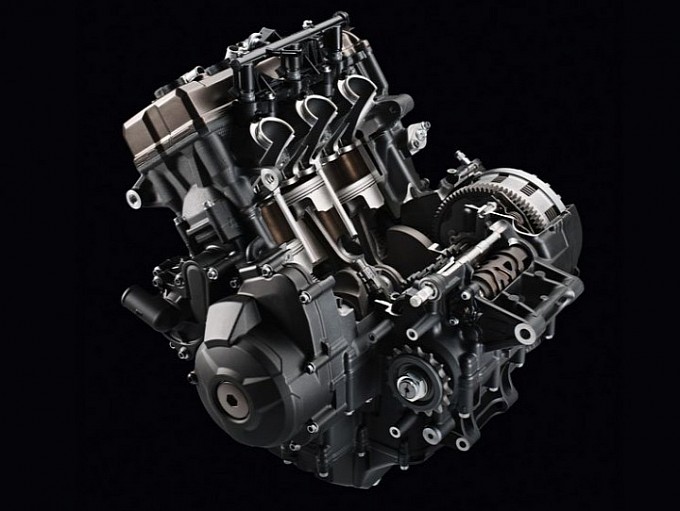So the Yammi version works better for several reasons, all related to it being the better designed engine of the two. I suspect it is more expensive to manufacture but, Yammi is likely able absorb much of that by using the engine in other applications.
You are quite right.
The Yamaha Genesis engine, in many different configurations, has seen some widespread use over the years.
Genesis is an engine design by the
Yamaha Motor Corporation that debuted in the 1984
Yamaha FZ750.
The engine employs a
DOHC design and uses five valves per cylinder with the cylinder group slanted forwards 45 degrees. It used
downdraft carburetors instead of the side draft carburetors that were more common at that time.
The same engine is used in the Yamaha FZX700 model, a naked bike that was introduced in the USA in 1986. Originally the engine was 750cc [FZ750], but due to
import restrictions 700cc was considerably cheaper, and therefore produced instead.
For more than ten years, until the 2007 model year, the
Yamaha YZF-R1 used a 5-valve head and downdraft intake design.
The flexible design of the engine allowed Yamaha to use it on a variety of configurations, from sportbikes to high performance outboard engines.
When the engine was introduced, it used downdraft carburetors on the entry level Yamaha FZ750 sportbike, in a 20 valve configuration, using three intake valves and two exhaust valves per cylinder. The engine has evolved on the different motorcycles that Yamaha has used it for during the past several years to fill different kinds of markets. Applications ranged from the Supersport YZF-R6 and YZF-R1 models using electronic fuel injection with YCCT and YCCI to the less extreme but still powerful Yamaha FZ6 (4 valve per cylinder) and FZ1 Fazer line, using a simpler fuel injection designs but essentially the same basic engine design. The most significant changes made were the 4-valve per cylinder configuration and the crossplane crankshaft found on the YZF-R1 2009, along with the change of cylinder sleeves to steel for high precision and high temperature durability. Performance and reliability have made this engine design a total success over its long life.
Because of its high performance capacity (usually from 100 BHP 350 BHP), the engine has also been employed in various other uses such as
gyroplanes and
high power marine engines, making it an affordable solution for a high performance applications.
The engine is also used in a
racecar championship in Norway called
SevenRacing. It is a copy of Lotus Super Seven, and is produced by MK and Stuart Taylor.
http://www.yamahamotorsports.com/sport/sno/tech_eng.aspx
INDUSTRY-DOMINATING 4-STROKE ENGINE TECHNOLOGY.
It isn’t something you buy from a vendor. It’s developed by a highly skilled team of engineers with over 50 years of engine-building experience. Yamaha’s engine department has developed a new, high-tech and reliable 4-stroke snowmobile engine for five out of the past six years. That’s an engineering track record nobody in the sport has been able to match. Yamaha engineers are dedicated to developing the best-performing, most-reliable and lowest-emission, lightweight engine packages in the industry. The new Genesis 130FI triple is the latest fast-revving, high-torque powerplant to hit the snow. It shares the same advanced fuel injection system as its 80 and 150 horsepower-class cousins, giving you razor-sharp throttle response, excellent fuel economy and dependable cold starting. Industry-leading technology isn’t something you outsource, it comes from within. Yamaha Motor Corporation delivers the very best engines in the sport… and they’re 4-strokes!
GENESIS 150FI
The high-performance 150hp-class Genesis 150FI engine is built with exotic materials and Yamaha’s high-tech manufacturing processes to be lightweight, durable and highly potent. The lightweight crank design and advanced fuel injection system give this engine right-now performance. Its broad power curve is easy to clutch and it delivers excellent acceleration out of a backshift.
Models:
Apex® RTX |
Apex LTX GT |
Apex LTX
Apex MTX SE |
Apex MTX |
Apex GT
GENESIS 130FI
The new fast-revving, high-torque, 130hp-class Genesis 130FI boasts a sizable performance gain over the Genesis 120. That gain can be credited to a slightly larger displacement, 1050cc 3-cylinder design and the introduction of Yamaha’s advanced fuel injection technology. The Genesis 130FI uses lightweight crank technology and the fuel injection system to deliver razor-sharp throttle response. It also features a new Engine Braking Reduction System to give riders some “coast” feeling when the throttle is released.
Models:
FX Nytro® RTX |
FX Nytro |
FX Nytro MTX
GENESIS 120
The smooth-running 120hp-class Genesis 120 triple has proven itself one of the most reliable engines in all of the sport. Its broad power curve and excellent fuel economy have earned the engine a strong following among high-mileage enthusiasts. Competitive 2-stroke engines fall off as soon as they achieve their peak horsepower. As you can see from the dyno chart, the Genesis 120 keeps pulling hard once it gets into the peak performance zone.
Models:
RS Vector® LTX |
RS Vector GT |
RS Vector
RS Venture® GT |
RS Venture
GENESIS 80FI
The lightweight, sporty 80hp-class Genesis 80FI powers the fun Phazer sleds. Its high-tech, fuel injection system gathers and analyzes data about the ambient conditions as well as from the engine to maintain optimum fuel flow. The fuel injection, combined with the Genesis 80FI’s lightweight, counterbalanced crank, gives it razor-sharp throttle response. A knock sensor helps protect the engine when you can’t find 91 octane fuel.
Models:
Phazer® RTX |
Phazer |
Phazer MTX |
Phazer GT |
Venture Lite









